How to Understand the Discrete SNP Optimization Horizon
Executive Summary
- Discrete optimization brings a higher level of reality to any optimization, with the cost bring longer run times and higher complexity.
- There is an important background to linear and discrete optimization.
- We cover the discrete constraints of the SNP network optimization and the deployment optimizer.

Introduction to Planning Horizon in APO
One of the primary ways to simplify or add complexity (and processing time) to any optimization run is to switch between linear versus discrete optimization. In this article, we will cover the advantages and disadvantages of each.
Background on Linear and Discrete Optimization
The SAP SNP Optimizer can perform only linear optimization or both linear and discrete optimization. Linear optimization is much faster but is not very realistic. Linear optimization would create smooth lines if one were to look at a graphical representation of the solution. In contrast, discrete optimization creates jagged step functions that require a great deal more calculation than when the optimizer can choose any order quantity that it wants.
- As long as the discrete constraints are set correctly, the optimizer will return recommendations in increments that the company would produce, procure, and transfer.
- Linear optimization will never return a realistic increment; instead, it will return the recommendation increment to minimize its costs. If a lot size is 50, linear optimization may result in any value.
Optimization and Time Consumption
Discrete optimization brings reality to the optimization run. In 23 runs of the network optimizer at a client, the average linear solve time was 3:22, while the discrete solve time consumed the rest of the allotted time – which was, on average, 9:05. Therefore 2/3rds of the allotted optimizer runtime at this client in the 23 optimizer runs was consumed by discrete optimization. This client only solved on average 62% of their sub-problems optimally (the optimizer at this client was used product decomposition – so a sub-problem would be the following):

The Overall Supply Network at XYZ Widget Company
This company sells two products, product A, and product B
- San Diego
- San Francisco
- Las Vegas
- Portland
- Los Angeles
- Seattle
- Phoenix
Sub-Problem 1 Product: A, Locations: San Diego, Los Angeles, Las Vegas Sub-Problem 2 Product: B, Locations: Portland, Seattle, Phoenix Each subproblem is the sub-network for that product. * For an analysis to be performed for a company, it would be necessary to change a setting, which controls how the optimizer log file is written. As it currently stands, there is not sufficient detail in the log trace file of the SNP optimizer to perform this analysis. Of course, a crucial fact to know is how long the discrete planning horizons were in this other company. I do not have the exact settings at the time of these test results. However, they were comparable both in their duration and in the number of discrete planning horizons used.
The Frequency of Use of the Discrete Planning Horizons
Due to the extra time required to perform discrete optimization, many companies place horizons on some or all of the discrete constraints that they use.
Discrete Planning Horizons in the Network and the Deployment Optimizer
Below is an example from one of the Network Optimization Profiles. The Network Optimizer and the Deployment Optimizer use different discrete constraints. I have included some average constraints and some of the most commonly populated discrete constraint horizons below:
Network Optimizer Discrete Constraints
- +Minimum PPM/PDS Lot Size: 16 Weeks
- +Integral PPMs/PDS: 16 Weeks
- *Min Transportation Lots: 10 Weeks. However, this definition is either incomplete or wrong, depending upon how you look at it. Because while transportation lots are rarely set on projects, what are set are the lot sizes on the Product Location Master.
- *Integral Transportation Lots: 10 Weeks (“Integral” settings are probably the most obscure. This means use integer based transportation lots. An integer is a whole number 1,2,3, not 2.5. This is an indirect way of simply saying that the constraint in question must be non-fractional. In the previous setting, transportation lots must not be less than “1”. ) Again, transportation lot sizes are rarely used in SNP. This definition is also incomplete. This actually refers to rounding values.
- *Integral Means of Transport: None
- Fixed Material and Resource Consumption: 125 Weeks
- PPM/PDS Execution: None
- *Means of Transport: None
- *Procurement Quantity: None
- Cross Period Lot Size: None
- Sequence Dependent Lot Size: None
All items with an asterisk are also used in the Deployment Optimizer.
Deployment Optimizer Discrete Constraints
- Min Transportation Lots: 8 Weeks
- Integral Transportation Lots: 8 Weeks
- Integral Means of Transport: None
- Means of Transport: None
- Procurement Quantity: None
Conclusion
One will naturally switch between discrete and linear optimization in the course of using the optimizer as required. Neither setting is “right” or “wrong”; it’s a matter of trade-offs.